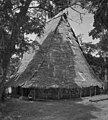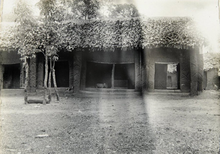
Odinani, also known as Odinala, Omenala, Odinana, and Omenana, is the traditional cultural belief and practice of the Igbo people of south east Nigeria. These terms, as used here in the Igbo language, are synonymous with the traditional Igbo "religious system" which was not considered separate from the social norms of ancient or traditional Igbo societies. Theocratic in nature, spirituality played a huge role in their everyday lives. Although it has largely been synchronized with Catholicism, the indigenous belief system remains in strong effect among the rural, village and diaspora populations of the Igbo. Odinani can be found in Haitian Voodoo, Obeah, Santeria and even Candomblé. Odinani is a pantheistic and polytheistic faith, having a strong central deity at its head. All things spring from this deity. Although a pantheon of other gods and spirits, these being Ala, Amadiọha, Anyanwụ, Ekwensu, Ikenga, exists in the belief system, as it does in many other Traditional African religions, the lesser deities prevalent in Odinani serve as helpers or elements of Chukwu, the central deity.

The Igbo people are an ethnic group in Nigeria. They are primarily found in Abia, Anambra, Ebonyi, Enugu, and Imo States. A sizable Igbo population is also found in Delta and Rivers States. Ethnic Igbo populations are found in Cameroon, Gabon, and Equatorial Guinea, as migrants as well as outside Africa. There has been much speculation about the origins of the Igbo people, which are largely unknown. Geographically, the Igbo homeland is divided into two unequal sections by the Niger River—an eastern and a western section. The Igbo people are one of the largest ethnic groups in Africa.
Ala is the female Alusi (deity) of the earth, morality, fertility, and creativity in Odinani. In Odinani, Ala rules over the underworld and holds the deceased ancestors in her womb. Her name literally translates to "ground" in the Igbo language, denoting her powers over the earth and her status as the ground itself. Ala is considered the highest Alusi in the Igbo pantheon. Ala's husband is Amadioha, the sky deity.

Spanning over three thousand years, ancient Egypt was not one stable civilization but in constant change and upheaval, commonly split into periods by historians. Likewise, ancient Egyptian architecture is not one style, but a set of styles differing over time but with some commonalities.
Most Goan houses standing today were built between the 18th century and the early part of the 20th century. They display a mix of neo-Classic and neo-Gothic styles.
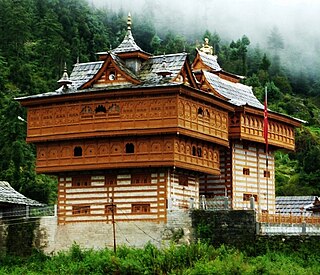
Indian vernacular architecture the informal, functional architecture of structures, often in rural areas of India, built of local materials and designed to meet the needs of the local people. The builders of these structures are unschooled in formal architectural design and their work reflects the rich diversity of India's climate, locally available building materials, and the intricate variations in local social customs and craftsmanship. It has been estimated that worldwide close to 90% of all building is vernacular, meaning that it is for daily use for ordinary, local people and built by local craftsmen.

Roof comb is the structure that tops a pyramid in monumental Mesoamerican architecture. Examination of the sections and iconography of Maya civilization roof-combs indicates that each icon had specific sacred meanings.

The Kingdom of Nri was a medieval polity located in what is now Nigeria. The kingdom existed as a sphere of religious and political influence over a significant part of what is known today as Igboland prior to expansion, and was administered by a priest-king called an Eze Nri. The Eze Nri managed trade and diplomacy on behalf of the Nri people, a subgroup of the Igbo-speaking people, and possessed divine authority in religious matters.

Igbo art is any piece of visual art originating from the Igbo people. The Igbo produce a wide variety of art including traditional figures, masks, artifacts and textiles, plus works in metals such as bronze. Artworks from the Igbo have been found from as early as 9th century with the bronze artifacts found at Igbo Ukwu. With processes of colonialism and the opening of Nigeria to Western influences, the vocabulary of fine art and art history came to interact with established traditions. Therefore, the term can also refer to contemporary works of art produced in response to global demands and interactions.
Igbo culture are the customs, practices and traditions of the Igbo people of southeastern Nigeria. It consists of ancient practices as well as new concepts added into the Igbo culture either by cultural evolution or by outside influence. These customs and traditions include the Igbo people's visual art, music and dance forms, as well as their attire, cuisine and language dialects. Because of their various subgroups, the variety of their culture is heightened further.

The architecture of Madagascar is unique in Africa, bearing strong resemblance to the construction norms and methods of Southern Borneo from which the earliest inhabitants of Madagascar are believed to have immigrated. Throughout Madagascar, the Kalimantan region of Borneo and Oceania, most traditional houses follow a rectangular rather than round form, and feature a steeply sloped, peaked roof supported by a central pillar.

Mbari is a visual art form practiced by the Igbo people in southeast Nigeria consisting of a sacred two- story house constructed as a propitiatory rite. Mbari houses of the Owerri-Igbo, which are large opened-sided square planned shelters contain many life-sized, painted figures. Mbari houses are made as a gift to Ala, as a way to acknowledge Ala's charitable and overarching presence. Some Mbari houses are dedicated strictly and solely to Ala. Sometimes, however, other gods are represented along with Ala in the structure. Other sculptures which could be included are of officials, craftsmen, foreigners, animals, legendary creatures and ancestors. Mbari houses take years to build and building them is regarded as sacred. Along with being representations of abundances and harmony, they are most usually created during times of peace and stability. A ceremony is performed within the structure for a gathering of town leaders. After the ritual is complete, going in or even looking at the Mbari house is considered taboo. Mbari are public shrine galleries where complex characters of Igbo mythology, folklore, and society are fleshed out in termite earth.
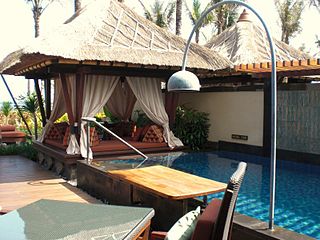
Balinese architecture is a vernacular architecture tradition of Balinese people that inhabits the volcanic island of Bali, Indonesia. Balinese architecture is a centuries-old architectural tradition influenced by Balinese culture developed from Hindu influences through ancient Javanese intermediary, as well as pre-Hindu elements of native Balinese architecture.
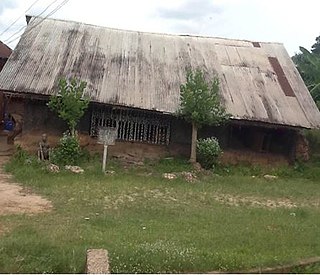
The Okoroji House Museum or Okoroji House,, is a historic house and museum located in Ujari, a village in Arochukwu, Abia State, Eastern Nigeria. The house was declared a national monument in 1972 by the National Commission for Museums and Monuments.

A wantilan is a Balinese pavilion (bale) used for activities involving large crowds. A wantilan is the largest type of bale in Balinese architecture. A wantilan is basically a large wall-less hall placed under a large multi-tiered roof. A wantilan as a public building is usually located at a village's main square or main junction and functions as an open hall to hold large community activities such as meeting halls or a public musical gamelan performance. A wantilan is also a religious building, an integral part of Balinese temples used to hold the Balinese cockfighting ceremony.
The architecture of Zimbabwe is composed of three architectural types: the Hill Complex, the Valley Complex, and the Great Enclosure. Both traditional and colonial architectures have influenced the history and culture of the country. However, post-1954 buildings are mainly inspired by pre-colonial, traditional architecture, especially Great Zimbabwe–inspired structures such as the Kingdom Hotel, Harare international airport, and the National Heroes' Acre.

Architecture of Nigeria was historically influenced by environmental conditions as well as social and cultural factors. The coming of missionaries and political changes brought about by colonialism precipitated a change in architectural style and utility of buildings. A Gothic revival style was adopted for early churches built in the colony of Lagos. A one or two-storey timber house building made with pre-fabricated material components and designed with the influence of classic antiquity styles served as mission house for the missionaries. Colonial residents working for the Public Works Department introduced a variant of neoclassical architecture to designs of government buildings and private residencies.

Hausa architecture is the architecture of the Hausa people of Northern Nigeria and Niger. Hausa architectural forms include mosques, walls, common compounds, and gates. Hausa traditional architecture is an integral part of how Hausa people construct a sense of interrelatedness with their physical environment. The architectural program used in this society is one disciplined by Islam and results in a highly organized spatial structure which is used to express features of Hausa culture.

Yoruba architecture describes the architectural styles of the Yoruba people of West Africa, dating back to approximately the 8th century. and lasted up to and beyond the colonial period beginning in the 19th century CE.

Songhai architecture or Zarma architecture refers to the traditional Sahelian architectural style of the Songhai people in West Africa. The architecture typically encompasses mud-brick buildings, flat roofs, and distinctive designs reflecting the cultural and historical aspects of the Songhai civilization.



